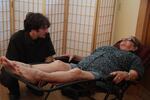
Doris Keene says acupuncture, along with exercise and a healthy diet, has helped her manage her pain.
Kristian Foden-Vencil / OPB
Doris Keene brought up four kids, walking everywhere and staying active. But the Portland native said when she turned 59 everything fell apart.
“My leg started bothering me," she said. "First it was my knees and then all along I think it was my sciatica but I just ignored it. I just tried to deal with it.”
Eventually, she went to a doctor who prescribed Vicodin and muscle relaxers. Keene says the drugs worked, but only to a degree. “My body was saying, ‘Well, if I take another one, maybe it’ll work.’ So I mean that’s just human nature. Especially when you’re in the kind of pain I was in," she said.
In the end, she said she became addicted.
At any given time, about 10 percent of Oregonians suffer from back pain. Many receive prescriptions for opioids, and some become addicted. In 2012, more than 900,000 Oregonians received an opioid prescription.
The state has taken notice. Starting in January, the Oregon Health Plan is changing the way it deals with back pain.
Oregon currently leads the nation in 'non-medical use' of opioids. That means the use of prescription drugs, whether obtained by prescription or otherwise, in a manner that was not prescribed.
About one third of hospitalizations related to drug abuse here are due to opioids.
Keene says her doctor cut her off.
“I got very upset with them when they told me I couldn’t have them no more. I said, ‘What do you mean? You gave them to me. Why’d you give them to me and then tell me that I couldn’t have them?’ ” she said.
Eventually, Keene was referred to The Quest Center for Integrative Health in Portland. It offers pain management in Portland, which is where OPB caught up with her.

Doris Keene receives acupuncture at the The Quest Center for Integrative Health in Portland.
Kristian Foden-Vencil / OPB News
Lying on a fold-out chair in a darkened room with about half a dozen other people, she was speckled with acupuncture needles. “I mean, I come in here wearing back braces, knee braces and a crutch. And Dr. Dave told me, 'Get rid of them. They’re just weakening your muscles.' And when I could walk out of here after the first acupuncture ... I was in shock. I wanted to grab him and kiss him,” she said.
Dr. Dave Eisen is the executive director of The Quest Center. He says doctors need to stop thinking of opioids as a first line of defense against pain. “There should be an array of things for people to choose from. Whether it be chiropractic care, naturopathic care, acupuncture, nutrition, massage, to try those things and if they don’t work you use opioids … as a last resort,” he said.
Eisen’s practice offers all those options plus mental health counseling, alcohol and drug treatment, Chinese medicines and psychiatric care.
The state wants patients to try this approach.
Denise Taray with the Oregon Pain Management Commission said traditionally, the Oregon Health Plan’s main way of dealing with back pain involved bed rest and pain killers. “The only thing that might have been covered in the past was narcotics … because those don’t require a diagnosis code to define coverage," she said.

Acupuncturist Ami Tai helps clients deal with their pain at The Quest Center for Integrative Health in Portland.
Kristian Foden-Vencil / OPB News
"But treatments such as acupuncture, chiropractor, massage therapy, physical therapy and rehab, those additional services would never have been covered, or still aren’t until 2016,” she said.
Starting January 2016, the state will fund many of those back pain treatments. The hope is to catch things early, stop the pain from becoming chronic, and reduce opioid addiction. “Research is out there that suggests that with back conditions we’re spending a lot of money on health care treatment and services that aren’t improving outcomes,” Taray said.
The Oregon Health Authority is working to calculate the cost of treating back pain within the Medicaid population. While some treatments may cost more than a course of pain pills, the hope is money could be saved by reducing the number of people who become addicted.
